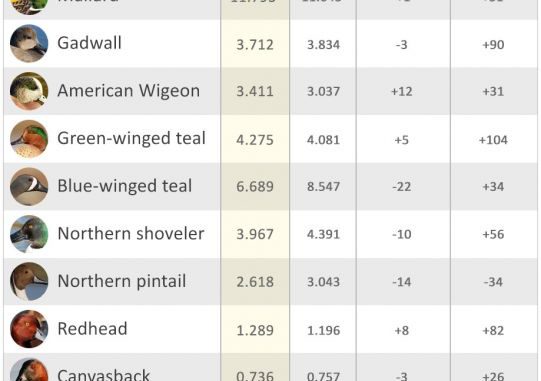
Most species remain well above long-term averages
Early summer surveys on the Canadian and U.S. breeding grounds revealed overall duck numbers are similar to last year and holding steady, according to a report from the U.S. Fish and Wildlife Service.
The 2016 Trends in Duck Breeding Populations estimates total populations at 48.4 million breeding ducks in the survey area — 38 percent above the 1955-2015 long-term average, but lower than last year’s estimate of 49.5 million birds.
The projected mallard fall flight index is 13.5 million birds, similar to the 2015 estimate of 13.8 million, the report states.
Conditions during the survey were generally poorer than last year, and the total pond estimate for the U.S. and Canada combined was 5 million, 21 percent below the 2015 estimate of 6.3 million but similar to the long term average.
“In light of the dry conditions that were observed across much of the northern breeding grounds during the survey period, it is reassuring to see that the breeding population counts were little changed from last year,” DU Chief Scientist Scott Yaich said. “But, with total pond counts similar to the long-term average, and with hunting season and winter mortality being a relatively small part of annual mortality, it’s not surprising to see that populations largely held steady.
“What’s not reflected in the report is that there was fairly significant improvement in habitat conditions after the surveys were completed. In some key production areas, heavy June and July rains greatly improved wetland conditions. This could benefit brood rearing and the success of late nesting species, as well as give a boost to overall production through re-nesting by early nesting species.”
The change in habitat conditions this season illustrates the importance of keeping a long-term perspective with conservation strategies, he said.
“First, we must simply accept that habitat and populations are going to vary over time. They always have and they always will,” Yaich said. “Second, that’s why we need to keep a steady hand on the course of our conservation efforts. Our job is to steadily make deposits into the habitat bank account so that when the precipitation and other conditions are right, the ducks will do the job that they do so well, which is to produce more ducks and provide us all a nice return on our investments.”
In Louisiana, duck season is now less than 100 days away. The Coastal and West Zone seasons are identical: The first split will be Nov. 12 – Dec. 4, with the second split set for Dec. 17 – Jan. 22.
In the East Zone, the season will run Nov. 19 – Dec. 4 and Dec. 17 – Jan. 29.
Youth hunts in the Coastal Zone will be Nov. 5-6, and in the West Zone, youth hunts will be held Nov. 5 and Jan. 28. In the East Zone, youth hunts will be Nov. 12 and Feb. 4.
The daily bag limit on ducks is six, and may include no more than four mallards (no more than two of which may be females), two canvasback, one mottled duck, one black duck, three wood ducks, three scaup, two redheads, and two pintails. The daily bag limit on coots is 15.


